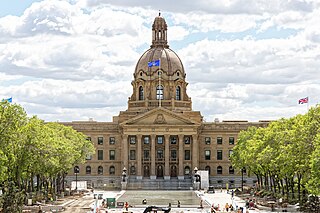
The University of Alberta is a public research university located in Edmonton, Alberta, Canada. It was founded in 1908 by Alexander Cameron Rutherford, the first premier of Alberta, and Henry Marshall Tory, the university's first president. It was enabled through the Post-secondary Learning Act. The university is considered a "comprehensive academic and research university" (CARU), which means that it offers a range of academic and professional programs that generally lead to undergraduate and graduate level credentials.

In the United States, the presidential library system is a nationwide network of 16 libraries administered by the Office of Presidential Libraries, which is part of the National Archives and Records Administration (NARA). These are repositories for preserving and making available the papers, records, collections and other historical materials of every president of the United States since Herbert Hoover, the 31st president from 1929–1933. In addition to the library services, museum exhibitions concerning the presidency are displayed.

Library and Archives Canada is the federal institution tasked with acquiring, preserving, and providing accessibility to the documentary heritage of Canada. The national archive and library is the 16th largest library in the world. The LAC reports to the Parliament of Canada through the Minister of Canadian Heritage.

The University of Lethbridge is a public comprehensive and research university located in Lethbridge, Alberta, Canada, with a second campus in Calgary, Alberta.

The National Library of Ireland is Ireland's national library located in Dublin, in a building designed by Thomas Newenham Deane. The mission of the National Library of Ireland is "To collect, preserve, promote and make accessible the documentary and intellectual record of the life of Ireland and to contribute to the provision of access to the larger universe of recorded knowledge."

The Royal Tyrrell Museum of Palaeontology is a palaeontology museum and research facility in Drumheller, Alberta, Canada. The museum was named in honour of Joseph Burr Tyrrell, and is situated within a 12,500-square-metre-building (135,000 sq ft) designed by BCW Architects at Midland Provincial Park.

The Glenbow Museum is an art and history regional museum in the city of Calgary, Alberta, Canada. The museum focuses on Western Canadian history and culture, including Indigenous perspectives. The Glenbow was established as a private non-profit foundation in 1955 by lawyer, businessman and philanthropist Eric Lafferty Harvie with materials from his personal collection.

The Art Gallery of Alberta (AGA) is an art museum in Edmonton, Alberta, Canada. The museum occupies an 8,000 square metres (86,000 sq ft) building at Churchill Square in downtown Edmonton. The museum building was originally designed by Donald G. Bittorf, and B. James Wensley, although portions of that structure were demolished or built over during a redevelopment of the building by Randall Stout.

The Royal Alberta Museum (RAM) is a museum of human and natural history in Downtown Edmonton, Alberta, Canada, located north of City Hall. The museum is the largest in western Canada with more than 7,600 square metres (82,000 sq ft) exhibition space and 38,900 square metres (419,000 sq ft) in total.

The Alberta Legislature Building, located in Edmonton, is the meeting place of the Legislative Assembly of Alberta and the Executive Council of Alberta. It is often shortened to "the Ledge".

Government House is the former official residence of the lieutenant governors of Alberta. Located in Edmonton's Glenora neighbourhood, since 1964 the restored and repurposed building has been used by the Alberta provincial government for ceremonial events, conferences, and some official meetings of the caucus.

The Dow Centennial Centre (DCC) is a multipurpose recreational facility in Fort Saskatchewan, Alberta, Canada. Constructed in 2003–2004 for the city's centennial, the 13,400-square-metre (144,000 sq ft) complex cost $22 million.

Alberta has been a tourist destination since the early days of the 20th Century, with attractions including national parks, National Historic Sites of Canada, urban arts and cultural facilities, outdoor locales for skiing, hiking and camping, shopping locales such as West Edmonton Mall, outdoor festivals, professional athletic events, international sporting competitions such as the Commonwealth Games and Olympic Winter Games, as well as more eclectic attractions.
Alberta Municipal Affairs is a ministry of the Executive Council of Alberta. Its major responsibilities include assisting municipalities in the provision of local government, administering the assessment of linear property in Alberta, administering a safety system for the construction and maintenance of buildings and equipment, and managing Alberta's network of municipal and library system boards.

By the arrangements of the Canadian federation, Canada's monarchy operates in Alberta as the core of the province's Westminster-style parliamentary democracy. As such, the Crown within Alberta's jurisdiction is referred to as the Crown in Right of Alberta, His Majesty in Right of Alberta, or The King in Right of Alberta. The Constitution Act, 1867, however, leaves many royal duties in Alberta specifically assigned to the sovereign's viceroy, the Lieutenant Governor of Alberta, whose direct participation in governance is limited by the conventional stipulations of constitutional monarchy.

The monarchy of Canada forms the core of each Canadian provincial jurisdiction's Westminster-style parliamentary democracy, being the foundation of the executive, legislative, and judicial branches of government in each province. The monarchy has been headed since September 8, 2022 by King Charles III who as sovereign is shared equally with both the Commonwealth realms and the Canadian federal entity. He, his consort, and other members of the Canadian royal family undertake various public and private functions across the country. He is the only member of the royal family with any constitutional role.
Crown corporations are government organizations in Canada with a mixture of commercial and public-policy objectives. They are directly and wholly owned by the Crown.

Archives of Manitoba, formerly the Provincial Archives of Manitoba until 2003, is the official government archive of the Canadian province of Manitoba. It is located at 200 Vaughan Street in Winnipeg, where it has been established since January 1971.
Manitoba Sport, Culture, Heritage and Tourism is the department of the Government of Manitoba responsible for managing government programs and services that support the sport, art, culture, and heritage of the province, through developing, supporting, promoting, and celebrating the identity and well-being of Manitoba and its communities.
The Archives Association of Ontario (AAO) is a professional network of archives and archivists based in Toronto, Ontario.




















